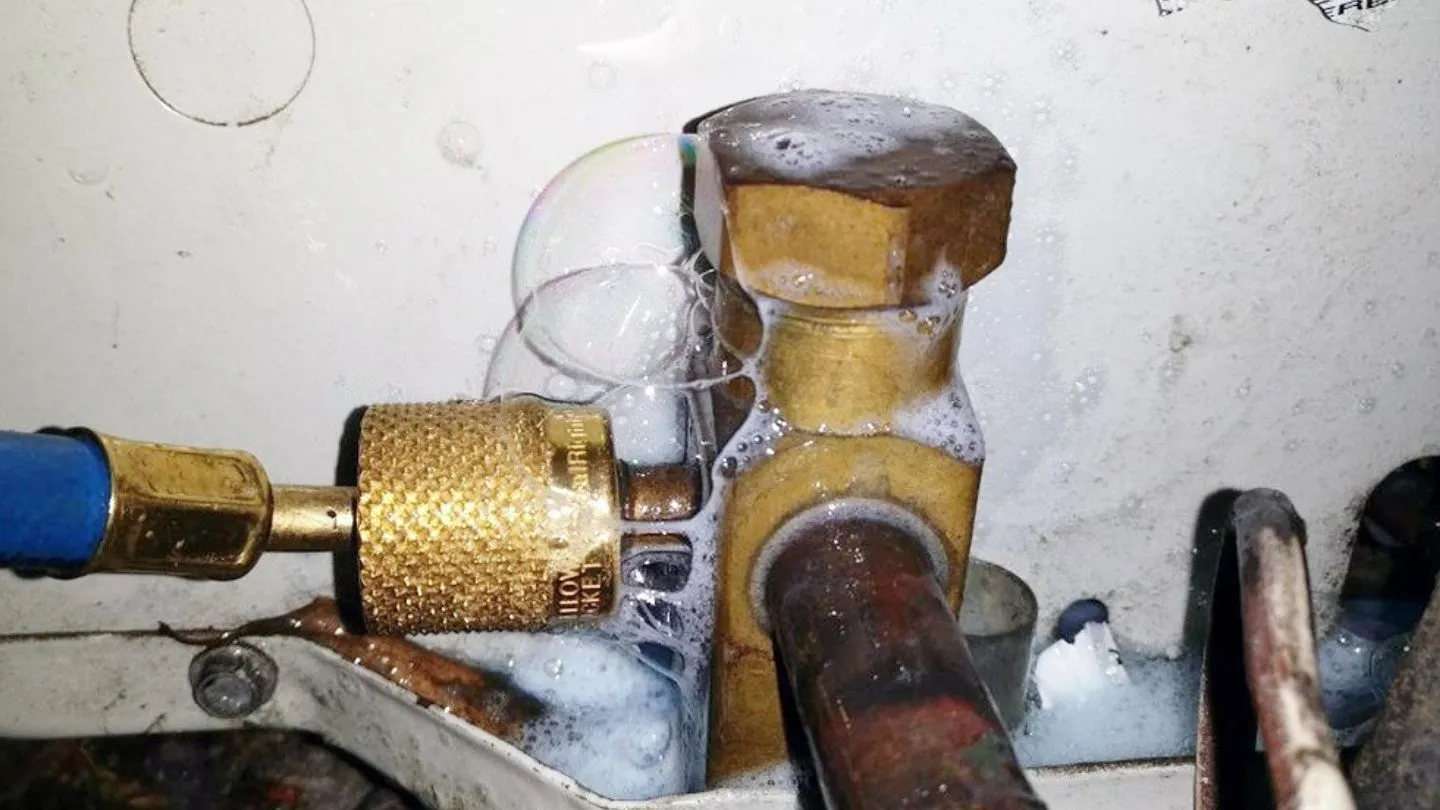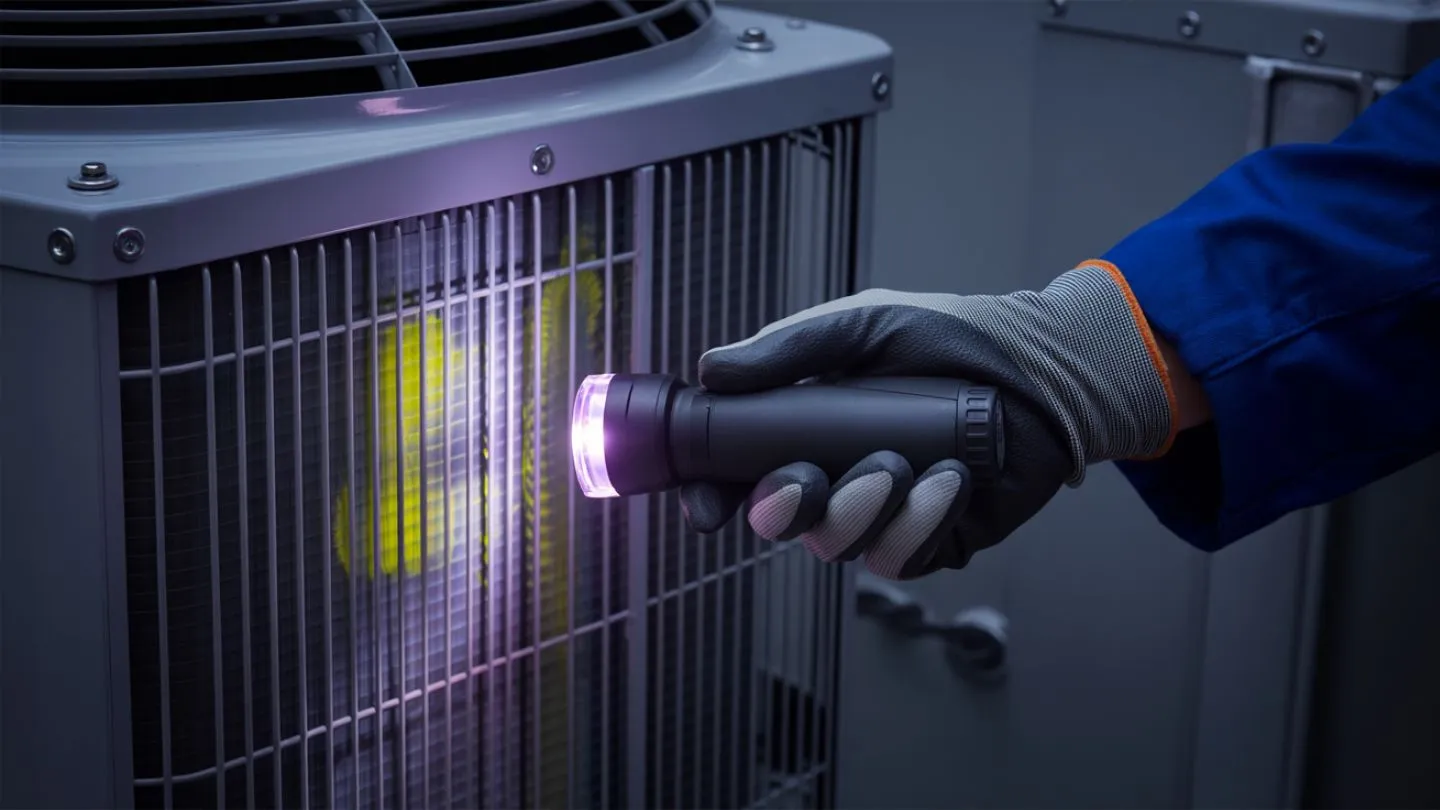How to Detect Gas Leaks in HVAC Systems?
Gas leaks in HVAC systems can pose serious safety risks and lead to inefficiency in your system. Detecting these leaks early is essential to ensure the safety of your home or workplace and maintain optimal performance. With the right tools and techniques, identifying gas leaks doesn’t have to be a daunting task. In this blog, we’ll walk you through the most effective methods for detecting gas leaks, including electronic detectors, pressure tests, and visual inspections. Let’s dive in and ensure your HVAC system stays safe and reliable.
Key Takeaways
- Understanding various leak detection methods, including the bubble test, pressure test, and electronic leak detectors, is crucial for accurately identifying refrigerant leaks in HVAC systems.
- Visual inspection remains an effective, fundamental technique for spotting refrigerant leaks by looking for signs such as oil accumulation and discoloration at connection points.
- Advanced methods like tracer gas testing and UV dye testing offer high sensitivity and accuracy for detecting micro-leaks and are essential for maintaining HVAC system efficiency.
Understanding the Sensitivity of Different Leak Detection Methods
Detecting gas leaks in HVAC systems requires a keen understanding of the sensitivity of different leak detection methods. Leaks can range from significant leaks, easily detectable by most methods, to micro-leaks, which are much harder to identify. Significant leaks are often the most urgent, requiring immediate attention to prevent further damage to the system and ensure safety.
Methods like the bubble test and pressure test are highly effective for larger leaks. The bubble test is straightforward and quick, making it ideal for spotting significant leaks. Applying a soapy solution to suspected areas results in bubbles forming at the leak points, offering a clear visual indication. The pressure test, involving pressurizing the system with nitrogen, is excellent for identifying pressure drops indicating larger leaks. A leak test can also be performed to ensure the integrity of the system.
Detecting smaller leaks, however, presents a unique challenge. Micro-leaks, defined as leaks as small as 0.5 grams per year, require more sensitive detection methods. Despite their size, these leaks can cause significant issues over time, making accurate detection crucial. At Total Comfort Cooling & Heating, we recognize the seriousness of a refrigerant leak and emphasize using the right tools and techniques for effective maintenance and repair decisions. A small leak can exacerbate these problems if not addressed promptly.
|
Method |
Leak Type Detected |
Precision |
Best For |
Tools Required |
| Bubble Test | Large leaks | Moderate | Quick, visual confirmation | Soapy solution |
| Pressure Test | Moderate to large leaks | High | System-wide leak checks | Nitrogen, pressure gauge |
| Electronic Leak Detector | Small to moderate leaks | Very High | Tight spaces, complex components | Sniffer device, halogen diode sensor |
| UV Dye Testing | Small to large leaks | High | Visual pinpointing in dark or hard-to-reach spots | UV light, fluorescent dye |
| Tracer Gas Testing | Micro-leaks | Ultra High | Micro-leak detection, critical systems | Helium/forming gas, mass spectrometer |
| Nitrogen Purge Testing | Fittings, connection points | High | Clean test environments, pinpointing specific areas | Nitrogen tank, sealed chambers |
| Visual Inspection | All visible leak types | Low to Moderate | Routine checks and early signs | Flashlight, basic tools |
Using Electronic Leak Detectors for HVAC Systems

Electronic leak detectors are indispensable tools for detecting refrigerant leaks in HVAC systems. Designed to identify even the smallest refrigerant leaks with high precision, these devices are vital for any HVAC technician’s toolkit. Using electronic leak detectors, often referred to as sniffers, is one of the most effective methods for locating air conditioner leaks.
An electronic leak detector’s functionality is straightforward yet highly effective. These devices use technologies such as halogen diodes and mass spectrometers to detect refrigerant gases. When sensing a leak, the detector typically emits a beeping sound or lights up, clearly indicating the leak’s presence. This method is especially useful in complex areas of the HVAC system, such as the evaporator coil, outdoor coil, indoor unit, and coils, where visual inspection might be challenging.
Using an electronic leak detector can significantly streamline the leak detection process for both HVAC professionals like Total Comfort Cooling & Heating and DIY enthusiasts. By accurately pinpointing HVAC leaks, these devices help ensure that repairs are targeted and effective, ultimately extending the life of the HVAC system and maintaining its efficiency. Additionally, they can help detect smaller leaks. Understanding how to keep your HVAC running smoothly can help homeowners grasp the crucial role tools like electronic leak detectors play in system upkeep.
Whether for new system installations or routine maintenance, keeping a reliable electronic leak detector on hand ensures HVAC systems stay in top condition with an air conditioning system and an AC tech.
Visual Inspection: Spotting Refrigerant Leaks with Your Eyes

Visual inspection remains a critical method for identifying refrigerant leaks in HVAC systems. Though basic, a thorough visual examination can reveal telltale signs of cooling leaks that might otherwise go unnoticed. This method involves carefully inspecting the system for any visible indications of refrigerant leakage.
A common sign of a refrigerant leak is oil accumulation on components like the evaporator or condenser coil. Since refrigerant is typically mixed with oil, a leak often leaves behind an oily residue. Discoloration on hoses or connections is another visual clue indicating a refrigerant leak. These changes in appearance can signal areas where the refrigerant is escaping.
Damage to parts such as the compressor or evaporator can also indicate refrigerant leaks. Additionally, inspecting for corrosion or rust on components can help identify potential leak sites. Regular visual inspections by Total Comfort Cooling & Heating enable HVAC technicians to catch leaks early, thereby minimizing damage and maintaining system efficiency.
Performing a Pressure Test to Find Leaks
A pressure test is crucial for identifying refrigerant leaks in HVAC systems. This method involves pressurizing the system with nitrogen to detect drops in pressure, which indicate the presence of leaks. Methods like pressure rise tests and foam-spray tests cater to specific applications, so choosing the right approach for your needs is important.
To begin a pressure test, the A/C system must be emptied and pressurized with nitrogen. At Total Comfort Cooling & Heating, this process is highly effective in revealing leaks that other methods might miss. If a significant leak is present, the pressure will drop quickly, often accompanied by an audible hissing sound. This immediate feedback quickly identifies and localizes the leak.
Combining a pressure test with the soap bubble test can enhance its accuracy. Once the system is pressurized, applying a soapy solution to suspected areas can visually confirm leaks, indicated by bubble formation. Using these methods together ensures a thorough and reliable leak detection process.
Tracer Gas Testing for Micro-Leak Detection
Tracer gas testing is among the best methods for detecting micro-leaks in HVAC systems. This technique involves introducing a tracer gas, such as helium or forming gas, into the system to identify leaks as small as 1 × 10^-9 scc/s. Its high sensitivity makes this method ideal for locating difficult-to-find leaks.
Helium, due to its non-toxic and non-flammable properties, is the most widely used tracer gas, making it safe for HVAC systems. Forming gas, a mixture of hydrogen and nitrogen, serves as a cost-effective alternative for tracer gas leak testing. These gases are detected using a mass spectrometer, which can identify minute concentrations of escaping gas.
The benefits of tracer gas testing extend beyond just detecting leaks:
- High-sensitivity leak detectors reduce energy loss and environmental harm by quickly locating and repairing leaks.
- This method ensures that even the smallest leaks are identified and addressed.
- It helps maintain HVAC system efficiency and performance.
UV Dye Testing for Accurate Leak Detection

UV dye testing is a highly effective method for accurately detecting refrigerant leaks in HVAC systems. This technique involves:
- Injecting fluorescent dye into the system during an evac/recharge process.
- Allowing the dye to circulate with the refrigerant.
- The dye is making its way to any leaks.
After introducing the dye, a UV light is used to inspect the system for leaks. The fluorescent dye glows under black light, clearly indicating leak locations. This method is particularly useful for detecting leaks in hard-to-reach areas and can identify both large and small leaks with high accuracy.
UV dye testing’s advantages include its reliability and efficiency. Providing a visual confirmation of leaks, this method ensures targeted and effective repairs. At Total Comfort Cooling & Heating, we use UV dye testing as an essential tool for HVAC professionals, helping maintain system performance and prevent costly damage from undetected leaks.
The Role of Nitrogen Purge Testing
Nitrogen purge testing is crucial for detecting leaks in HVAC systems, especially at fittings and brazed connection points. This method uses nitrogen gas to pressurize the system, allowing for accurate leak detection by reducing background contamination and false leak failures.
The process involves isolating the area being tested with an inner and outer chamber, then analyzing the gas mixture with a mass spectrometer. This setup ensures a precise and reliable leak detection process, minimizing operator error. Nitrogen and helium are commonly used gases for this testing procedure.
Benefits of nitrogen purge testing include improved measurement accuracy and effective leak identification in subassemblies and attachment points. This method is essential for maintaining HVAC system integrity and performance, ensuring even the smallest leaks are detected and repaired promptly.
Prioritizing Safety and System Efficiency
Detecting gas leaks in HVAC systems is critical for protecting your home, health, and overall comfort. By staying alert to warning signs, scheduling regular inspections, and addressing issues promptly, you can prevent hazards while keeping your system operating safely and efficiently.
At Total Comfort Cooling & Heating, we are committed to providing dependable solutions that keep your home safe and comfortable. If you need expert care for your HVAC in Port Charlotte, our team can inspect, repair, and maintain your system to ensure reliable performance and peace of mind year-round. Contact us today to schedule an inspection and keep your HVAC system running smoothly.
Frequently Asked Questions
What is the benefit of a high-efficiency HVAC system?
A high-efficiency HVAC system significantly reduces energy consumption, leading to lower utility bills and enhanced comfort levels in your space. Investing in such a system is a savvy choice for both your finances and overall well-being.
How can I tell if my HVAC system has a gas leak?
You may notice signs such as reduced cooling efficiency, unusual odors, higher energy bills, or oil accumulation near components. Leak detection methods like electronic detectors, pressure tests, and visual inspections can help confirm the issue.
What is the most reliable method to detect micro-leaks in an HVAC system?
Advanced techniques like tracer gas testing and UV dye testing are highly effective for detecting micro-leaks due to their sensitivity and accuracy.
How often should I check my HVAC system for leaks?
It’s recommended to inspect your HVAC system for leaks during routine maintenance, typically once or twice a year, or whenever you notice a drop in performance or efficiency.
READY FOR YOUR NEXT HEATING OR COOLING PROJECT?
Contact us to get a quote and see why our customer service is recognized as the best in the industry.







 Special Offer: 12 Months - No Interest, No Payments!
Special Offer: 12 Months - No Interest, No Payments!